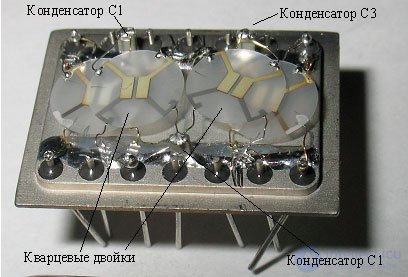Lecture
As previously discussed, the selectivity of the receiver on the adjacent channel is provided by the filter of the main selectivity. This filter is a band-pass filter with specified parameters. The requirements for a basic selectivity filter have been discussed in previous chapters. Bandpass filter can be implemented by various technical means. These can be active RC filters, filters on switchable capacitors, LC filters, electromechanical filters, quartz filters or surface acoustic wave filters (SAW filters).
When calculating the basic selectivity filter, the usual methods for calculating the bandpass filter are used. This means that filters can be constructed with various types of approximation of amplitude-frequency characteristics. Considering that when building a radio receiving device it is very important to provide suppression of interfering signals that are well tuned in frequency from the frequency of the useful signal, approximation of the amplitude-frequency characteristics according to Butterworth and Chebyshev is most often used.
Currently, quartz filters and filters based on surface acoustic waves are most common in intermediate frequency amplifiers. This is due to their relative cheapness and excellent electrical and design parameters. It is very important for the receiver that its parameters do not change during operation, do not depend on external influences and temperature changes. It is quartz crystals that have the most stable parameters, although in some cases other materials with a piezoelectric effect are used.
Currently, a number of companies offer ready-made solutions that can satisfy almost any requirements arising in the design of a radio receiving device, so in most cases the development of a concept is reduced to the selection of the most suitable filter offered on the world market.
In order to make the right choice of a specific filter model, it is necessary to clearly understand the physics of the operation of quartz filters. The most widely used filters made on quartz "twos". In a quartz two, on one plate of a quartz crystal there are two resonators, which are interconnected by means of an acoustic coupling.
From an electrical point of view, a quartz two is equivalent to a dual-circuit LC system. Depending on the depth of the acoustic coupling between the resonators, either one-humped or two-humped amplitude-frequency characteristic can be realized. The quality factor of the resonators in the high-order filter should also be different in order to realize the Chebyshev or Butterworth approximation of the amplitude-frequency characteristic of the filter as a whole. Between quartz doubles, the electrical connection is usually carried out using external capacitors. An example of an eighth-order quartz filter circuit built on quartz twos is shown in Figure 1.

Figure 1 Scheme of quartz filter, built on quartz twos
In this figure, four quartz twos are applied. The connection between them is carried out using capacitors C1, C2 and C3. Such a filter allows for a fairly high squareness ratio. The design of this quartz filter in the form of a finished module with the cover removed is shown in Figure 2.

Figure 2. The design of the quartz filter
The matching of the input and output impedance of the quartz filter with the output of the mixer and the input of the subsequent intermediate frequency amplifier is carried out using LC circuits.
When receiving digital types of modulation, the phase response of the basic selectivity filter is extremely important. Filters made on surface acoustic waves (surfactants) have a linear phase characteristic, so this direction of filters is being actively developed now, but in some cases the use of surfactants filters is impossible.
Comments
To leave a comment
Devices for the reception and processing of radio signals, Transmission, reception and processing of signals
Terms: Devices for the reception and processing of radio signals, Transmission, reception and processing of signals